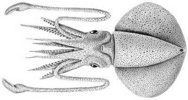Discoteuthis
Richard E. Young


This tree diagram shows the relationships between several groups of organisms.
The root of the current tree connects the organisms featured in this tree to their containing group and the rest of the Tree of Life. The basal branching point in the tree represents the ancestor of the other groups in the tree. This ancestor diversified over time into several descendent subgroups, which are represented as internal nodes and terminal taxa to the right.

You can click on the root to travel down the Tree of Life all the way to the root of all Life, and you can click on the names of descendent subgroups to travel up the Tree of Life all the way to individual species.
For more information on ToL tree formatting, please see Interpreting the Tree or Classification. To learn more about phylogenetic trees, please visit our Phylogenetic Biology pages.
close boxIntroduction
Discoteuthis is easily recognized by the large fins, small tentacular clubs and the presence of only suckers on the arms. It is broadly distributed in tropical and subtropical waters of all oceans. These squid have never been observed alive and little is known about their biology or ecology. Discoteuthis sp A could be the mature male of D. discus.
Brief diagnosis:
A cycloteuthid ...
- with large, oval fins that extend the full length of the mantle.
Characteristics
- Tentacles
- Medial suckers on manus of club greatly enlarged.
- Medial suckers on manus of club greatly enlarged.
- Mantle
- Tail absent.
- Tail absent.
- Fins
- Fins large, oval; length equal to ML in subadults.
- Fins large, oval; length equal to ML in subadults.
- Photophores
- Photophore arrangement varies with species. Photophores absent from eyes and viscera.
Comments
The following table compares the four possible species.
| Shape of groove of funnel locking-apparatus | Mantle photophores | Head photophores | Brachial crown photophores | Free anterior mantle margin with tissue flaps | Dentition of large manus suckers | |
| D. discus | Diagonal | At posteroventral mantle apex | Four ? | None | No | Numerous, small, flattened to rounded teeth |
| Discoteuthis sp. A | Diagonal | At posteroventral mantle apex | Four | Series on arms I | No | None. Teeth absent |
| Discoteuthis sp. B | V-shaped | ?? | ?? | ?? | ?? | Numerous small, pointed teeth |
| D. laciniosa | V-shaped | At anteroventral mantle margin | None | On web between arms III & IV | Yes | Numerous irregular, low scalloped teeth |
References
Young, R. E. and C. F. E. Roper. 1969. A monograph of the Cephalopoda of the North Atlantic: The family Cycloteuthidae. Smithsonian Contributions to Zoology No. 5:1-24.
Title Illustrations

| Scientific Name | Discoteuthis discus |
|---|---|
| Location | Off West Africa, 4°N, 3°W |
| Reference | from Young, R. E. and C. F. E. Roper. 1969. A monograph of the Cephalopoda of the North Atlantic: The family Cycloteuthidae. Smithsonian Contributions to Zoology No. 5:1-24. |
| View | Ventral |
| Size | 53 mm ML |
| Type | holotype |
| Image Use |
 This media file is licensed under the Creative Commons Attribution-NonCommercial License - Version 3.0. This media file is licensed under the Creative Commons Attribution-NonCommercial License - Version 3.0.
|
| Copyright |
©

|
About This Page

University of Hawaii, Honolulu, HI, USA
Page copyright © 2019
 Page: Tree of Life
Discoteuthis .
Authored by
Richard E. Young.
The TEXT of this page is licensed under the
Creative Commons Attribution-NonCommercial License - Version 3.0. Note that images and other media
featured on this page are each governed by their own license, and they may or may not be available
for reuse. Click on an image or a media link to access the media data window, which provides the
relevant licensing information. For the general terms and conditions of ToL material reuse and
redistribution, please see the Tree of Life Copyright
Policies.
Page: Tree of Life
Discoteuthis .
Authored by
Richard E. Young.
The TEXT of this page is licensed under the
Creative Commons Attribution-NonCommercial License - Version 3.0. Note that images and other media
featured on this page are each governed by their own license, and they may or may not be available
for reuse. Click on an image or a media link to access the media data window, which provides the
relevant licensing information. For the general terms and conditions of ToL material reuse and
redistribution, please see the Tree of Life Copyright
Policies.
Citing this page:
Young, Richard E. 1999. Discoteuthis . Version 01 January 1999 (under construction). http://tolweb.org/Discoteuthis/19621/1999.01.01 in The Tree of Life Web Project, http://tolweb.org/







 Go to quick links
Go to quick search
Go to navigation for this section of the ToL site
Go to detailed links for the ToL site
Go to quick links
Go to quick search
Go to navigation for this section of the ToL site
Go to detailed links for the ToL site